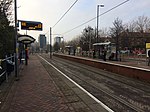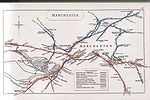Trafford Park is an area of the Metropolitan Borough of Trafford, Greater Manchester, England, opposite Salford Quays on the southern side of the Manchester Ship Canal, 3.4 miles (5.5 km) southwest of Manchester city centre and 1.3 miles (2.1 km) north of Stretford. Until the late 19th century, it was the ancestral home of the Trafford family, who sold it to financier Ernest Terah Hooley in 1896. Occupying an area of 4.7 square miles (12 km2), it was the first planned industrial estate in the world, and remains the largest in Europe well over a century later.Trafford Park is almost entirely surrounded by water; the Bridgewater Canal forms its southeastern and southwestern boundaries, and the Manchester Ship Canal, which opened in 1894, its northeastern and northwestern. Hooley's plan was to develop the Ship Canal frontage, but the canal was slow to generate the predicted volume of traffic, so in the early days the park was largely used for leisure activities such as golf, polo and boating.
British Westinghouse was the first major company to move in, and by 1903 it was employing about half of the 12,000 workers then employed in the park, which became one of the most important engineering facilities in Britain.
Trafford Park was a major supplier of materiel in the First and Second World Wars, producing the Rolls-Royce Merlin engines used to power both the Spitfire and the Lancaster. At its peak in 1945, an estimated 75,000 workers were employed in the park. Employment began to decline in the 1960s as companies closed in favour of newer, more efficient plants elsewhere. By 1967 employment had fallen to 50,000, and the decline continued throughout the 1970s, when difficult economic conditions were pushing up unemployment nationally.
The new generation of container ships was too large for the Manchester Ship Canal, which led to a further decline in Trafford Park's fortunes. The workforce had fallen to 15,000 by 1976, and by the 1980s - in the wake of another recession - industry had virtually disappeared from the park.
The Trafford Park Urban Development Corporation, formed in 1987, reversed the estate's decline. In the 11 years of its existence, the park attracted 1,000 companies, generating 28,299 new jobs and £1.759 billion of private-sector investment. As of 2008, there were 1,400 companies within Trafford Park, employing an estimated 35,000 people. Despite a decline in these numbers soon afterwards due to a fresh recession, the area was recovering well a decade later with economic growth re-established and unemployment reduced.








